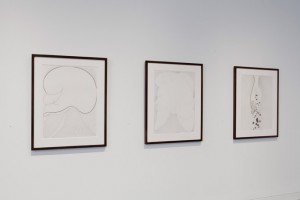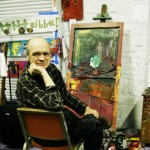Two F Newsmagazine staff writers reflect on their experiences with Chris Ofili’s exhibition “Afrotranslinear,” on view at the Arts Club this fall and winter.
Dispatched from an Earthly Heaven
By Ziyuan Wang
Distinguished by overflowing color and purposeful misquotations of holy and profane imagery, Chris Ofili’s status as a celebrated young artist has only been enhanced by the controversy generated by his work. This controversy is largely tied to his signature material, elephant dung — which is usually varnished and globe-shaped, and omnipresent in his oeuvre. Ofili is likely most infamous for his dung-spattered 1996 collage Holy Virgin Mary, which was condemned to be “sacrilegious” by religious groups when it was exhibited in New York, resulting in a court trial. In this trial, Mayor Giuliani sided with the protesters in a failed attempt to evict the painting from its exhibition space, claiming this representation of Virgin Mary incorporating elephant dungas very “sick”; the parallels with a similar case at the Smithsonian in recent months is striking.
“Afrothanslinear,” Ofili’s recent exhibition at the Arts Club Chicago, fortunately chose not to dwell on controversy, and instead focused on the artist’s consummate skill, dedicating the whole first floor to a comprehensive survey of the artist’s early works on paper. Many of the 116 pieces were on view for the first time, including series of black and white drawings visually unified by Ofili’s trademark, interwoven “afro heads”, juxtaposed with elaborate watercolor portraits of African men and women.
A common thread running through the exhibited works was a tribute to love and unity, made explicit by recurring heart shapes and coalescing male and female forms. No matter how subversive Ofili’s interpretation of religion might appear, the artist himself seems to be a deeply religious person. It’s just a religion that turns away from preaching and dogma, and instead celebrates heavenly and earthly joys, and the unification of human beings. He creates a vision of a promised land that is abundant with love, beauty and harmony.
However, Ofili’s paintings don’t literally depict heaven; they are instead testaments to the search for the fulfillment of desire, both human and spiritual. The risk of doing this is to become a preacher; however, Ofili made a conscious effort to avoid any stern moralist sermon. A good life is within reach, as one of his graphite paintings seems to suggest; the work features a heart shaped frame features a cuddling couple, their limbs and torsos are interwoven into an organic whole. Ofili describes the piece as, “dreaming of a place where at least two people are happy. Starting from that premise, where two people are happy being in the same place with each other, and hoping that that’s infectious.” His art is oozing warmth and humor, so intense that one feels an irresistible impulse to laugh and cry at his painting simultaneously.
In an era when images are easily pixelated, compressed, coded and subtracted, Ofili dedicates himself to the weight of the physicality of painting, creating works with supreme painterly skill. A masterly craftsman, his works are free from the supposed limitations of the medium. In one series of 112 drawings, for instance, he demonstrates how the variation of a single element can create a powerful effect. Without depicting facial expressions or body language, he humorously plays with shapes and varying formation of African hairdos, expressing a rich variation of emotions: ecstasy, agony, rapture, frustration, depression and many other subtleties in between.
In addition to excellent draftsmanship, Ofili has much to offer in his watercolors. With an unrestrained palette of vibrant and exuberant color, groups of portraits serve as a celebration of beauty and life. Akin to ethnological studies, these portraits of African men and women pay special attention to their hairstyle, attire and ornaments. Facial features are largely omitted, leaving only expressive eyes and the lips. The contours are smeared by the inky colors, while the intricate patterns on their clothes and head ornaments are rendered with fastidious detail, as in homage to fashion as self-representation. This is indeed an homage to Ofili’s African heritage, and a long, loving gaze at a visual history of deeply spiritual imagery.
Good Work, Hard to Overcome Expectations
By Alejandra Monserrat González Romo
Chris Ofili has a long story of controversy in his career as an artist. His incorporation of elephant dung into his art pieces might have earned him some harsh criticism and confrontation, but they have also garnered him plenty of fame.
More importantly, though Ofili is an artist devoted to representing and analyzing African societies and their influence and evolution on the rest of the word; and this is not an easy road to take in a Western driven art world. However, Ofili has managed to succeed in this journey, earning recognition even through one of the mainstream art world’s greatest markers of success: the Turner Prize.
The artist’s work on view at the Arts Club this fall showed skill, talent and creativity in his attempt to portray a culture’s religion, history, pain and triumphs in a colorful, playful way.
Ofili´s pieces scream their message as tiny smiling Afro heads link to one another, forming beautiful and finely precise drawings that celebrate their Nigerian heritage. Cultural diversity is represented by beautiful colors and patterns in clothes, hair and garments, in works that are far more gentle and innocent than some of his most famous pieces.
When I visited this exhibition this winter, I was in the company of a few elderly patrons, who spent a long time viewing and discussing the work. All of a sudden, two middle-aged women entered the gallery, quickly walked through it, and then immediately left. I overheard one ask the other “Did you like it?” To which her friend replied, “Not really, it looks like folk art to me.”
Unfortunately, this anecdote might be truly representative of the way most people approach art about African cultures. The Western world is still in many ways the self-proclaimed center of the art world. Chris Ofili might be recognized worldwide, but his work can still be reduced to a peripheral status by those who still cling to a traditional canon.























